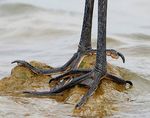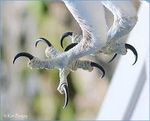Wednesday, February 17 - Buena Vista Audubon
←
→
Page content transcription
If your browser does not render page correctly, please read the page content below
BUENA VISTA AUDUBON SOCIETY
Wednesday, February 17
LAGOON Social time: 6:45 p.m.
Program (see below) begins: 7:00 p.m.
Please RSVP to Bob Crowell at
FLYER
kbcrowell1@att.net
if you would like to join us on
Zoom.
Your invitation will be emailed to
you the day of the lecture.
VOLUME 50 / NUMBER 2 / FEB. 2021
Conservation Breeding and Release of
San Clemente Loggerhead Shrikes
with Susan Farabaugh, Ph.D.
In the late 1980s, the U.S. Navy approached the San Diego
Zoo asking for assistance in the recovery of the San
Clemente Loggerhead Shrike. This shrike subspecies is
found only on the U.S. Navy’s San Clemente Island, a
highly valued training site. Numbers had dropped to as low
as 14 birds and the Navy wanted help to create a captive
breeding population. In 1991, the first three clutches were
pulled from wild nests and brought to the zoo for artificial
incubation and hand rearing. Thus began a nearly 30-year
collaboration among the zoo, the Navy, and various other
conservation partners.
Banded and released Loggerhead
Shrike. Photo by Stefan Gleissberg Dr. Susan Farabaugh, who now manages the zoo’s
shrike recovery program and the Hawaii Endangered
Bird Conservation Program, joined the zoo in 1997. But
before then, Susan’s ornithological path took her far afield—
Panama, Venezuela, Hawaii, Australia, and New Zealand.
This vast experience makes her uniquely suited to discuss
what has been learned about successful conservation
breeding and how the release of conservation birds has
affected the wild.
This story reflects both challenges
and cautions. However, it’s the
successes with this small but fierce
songbird that will leave you most
inspired. Join us on February 17 on
Zoom. You won’t want to miss it. Shrike chicks getting banded.
Photographed by San Diego Zoo staff.BIRD OF THE MONTH VOLUME 50 / NUMBER 2 / FEB. 2021 / 2
Buena Vista’s Charming Symbol,
The Ruddy Duck
Sporting a dapper black cap, a sky-blue bill
accentuating a chestnut-brown body, a gleaming
white cheek patch, and black perky tail feathers,
a male Ruddy Duck in breeding season
assumes an entirely different bearing from his
nondescript winter alter ego. All in all, with its
small size, broad flattened bill,
disproportionately large head, and distinct, stiff
tail, the Ruddy Duck just looks cute whatever
the season.
Ruddies prefer habitats with extensive stands of
aquatic vegetation and open areas for takeoffs
and landings. In winter, they also use coastal Breeding male by Alan Tilmouth
bays ranging from fresh to brackish, marshes,
and tidal estuaries. In San Diego County, the
Ruddy Duck is locally common as a breeding bird and abundant as a winter visitor in lagoons and
freshwater lakes and ponds. Indeed, at many places, it is the most abundant wintering duck, although
less conspicuous than others because of its small size, reluctance to fly, and drab winter plumage.
Ruddies eat both vegetation (e.g., duckweed,
pondweed, arrowhead, bulrushes) and animal
matter (adult and larval insects). During breeding
season, though, both adults and ducklings feed
extensively on midge larvae. If available, Ruddies
will also capture crustaceans, zooplankton, and
other invertebrates. Adults forage almost
exclusively by diving but occasionally they skim
the water surface, straining food from water.
Nesting locations for the Ruddy Duck are
scattered throughout San Diego County’s coastal
slope but are most concentrated in the northwest.
The San Diego County Bird Atlas reported the
largest concentration at our very own Buena Vista
Female by Anthony Mercieca Lagoon and in the west basin.
San Diego County’s population of Ruddy Ducks
expands greatly in winter, thanks to migrants from the north and northeast. The winter migrants arrive
in October and November and begin to leave in March. In large part because of their large, broad
bills, Ruddies remind people of different characters, depending on their frame of reference. Looney
Tunes? Daffy Duck. Classic literature? Cyrano de Bergerac. Muppets and Sesame Street? By overall
cuteness, Ernie’s bathtub Duckie. So stop by a nearby body of water while these sprites are most
plentiful and make your own association.
To learn more about the Ruddy Duck, visit https://bvaudubon.org/news/.BIRDING WITH BVAS VOLUME 50 / NUMBER 2 / FEB. 2021 / 3
Since the situation with COVID-19 is ongoing EL CORAZON GARRISON CREEK (Oceanside)
and uncertain, we are canceling all birding From the intersection of El Camino Real and
opportunities for February. Please enjoy the Oceanside Blvd., go east on Oceanside Blvd., turn
birds and nature on your own, whenever left (north) into the first gate. Park to the left.
possible. The places where our guided tours are
normally held are generally open to visitors. COASTAL 101 BIRDING (Oceanside)
2202 S Coast Highway
Go birding around the Buena Vista Lagoon’s 0.25-
BIRDING LEO CARRILLO (Carlsbad) mile loop trail at the Nature Center, then go south
Leo Carrillo Ranch Historic Park is now open along the 101 to look for waterfowl.
every day. In addition, the 4-mile Rancho Carrillo
Loop Trail that encircles Leo Carrillo Ranch Historic SAN DIEGUITO RIVER PARK (Del Mar)
Park has at least six trailheads that provide access to Directions for San Andres Drive— From I-5, take
the trail. Google for the trailhead nearest you. Via de la Valle east; go right on San Andres Drive to
end of road.
WHELAN LAKE BIRD SANCTUARY (Oceanside)
3850 N. River Road
For access, contact Greg Kackstetter (760)
722-4887.
ADAPTATIONS— VARIATION IN FEET
In the last issue we looked at the leg and foot
anatomy of birds. In this issue we consider a few
examples of the great variety of evolutionary
modifications of the foot and toes. (b.) Totipalmate—Brown Pelican
Swimming— Webbed feet come in two different Photo: J. Mygatt
configurations: palmate (a.), where three toes are (a.) Palmate—Mallard
Photo: Casey Kreider
connected by webbing (e.g., gulls, ducks, and
geese), and totipalmate (b.), where all four toes
are connected by webbing (e.g., pelicans,
boobies, and cormorants).
Catching Prey— Birds of prey have raptorial
(c.) feet, three toes forward, one backward (e.g.,
eagles, hawks, and falcons). Raptors have sharp,
powerful claws with talons used to grasp prey. In
the case of Ospreys, one of their forward-pointing
toes can rotate towards the back (d.), which can (c.) Raptorial—Cooper’s Hawk
Photo: Lloyd Spitalnik
aid in grasping slippery food such as fish. (d.) Raptorial—Osprey
Perching— Songbirds (e.g., robins, finches, and Photo: Kim Begay
bluebirds) have anisodactyl feet, three toes in
front, one backward (e.). Birds with this common
arrangement are able to easily grip and clasp
objects such as tree branches.
Wading— Wading birds (e.g., cranes, herons,
and some shorebirds) often have long slender
legs and long toes to walk effortlessly through
shallow water and mud. Arranged with three
forward and one backward (f.), long toes help (e.) Anisodactyl—American Pipit
waders walk through mud without losing their Photo: J. Mygatt
balance. (f.) Great Blue Heron
Climbing— Woodpeckers, nuthatches, and Photo: Kevin Kurtz
flickers have specially adapted toes in a
zygodactyl arrangement to help them cling on
tree trunks. Two toes in front and two behind
accommodate climbing up and down the bark of
trees (g.). (g.) Zygodactyl—
Northern Flicker
Photo: www.bentler.us
dCBC RESULTS VOLUME 50 / NUMBER 2 / FEB. 2021 / 4
Summary of Oceanside’s (CAOV) Christmas Bird Count — 2020
The 75th Oceanside Christmas Bird Count (CBC) was held on December 26, 2020. A dedicated group
of 80 birders logged 237 hours of birding and 455 miles of travel on foot, by car, by boat, and by golf
cart. The teams recorded approximately 32,440 individual birds. The total number of individual birds
counted was up by approximately 2,400, or 8% when compared with last year. That is impressive
considering we had fewer birders this year, below-average rainfall. We also
were not able to survey Camp Pendleton sectors due to the COVID-19
pandemic. Many thanks to all the team leaders and members for their
outstanding efforts!
A total of 184 species was detected, which is about average for this count.
(The count record of 200 species was set some years ago.) The most
numerous birds were returning champs:
American Crow at 2829, Yellow-rumped
Warbler at 2649, American Coot at 1969,
American Wigeon at 1349, House Finch at
1855, and White-crowned Sparrow at 1692
Photo by Tito Gonzales.
birds. Black-vented Shearwaters were also
numerous at 2240 birds.
Many rarities were detected as well. Appearing for the very first time on
the Oceanside count, a Verdin (above) and a Hammond’s Flycatcher.
Additional rarities included Tropical Kingbird, Ash-throated Flycatcher,
Mountain Bluebird, American Redstart, Ridgway’s Rail, Bullock’s Oriole,
Purple Finch
spotted by
Wilson’s Warbler, and two Nashville Warblers.
Carol Manning.
Other birds of interest were Gray Flycatcher, Common Goldeneye, Hairy
Woodpecker, Clay-colored Sparrow, Yellow Warbler, Green-tailed
Towhee, Western Tanager, Greater White-fronted Goose, Snow Goose, Glaucous-winged Gull, White-
winged Scoter, Summer Tanager, and Costa’s Hummingbird.
Several species were at record lows, including Snow Goose,
Canada Goose, and Bonaparte’s Gull at one individual each. A
total of 4 White-tailed Kites were reported, near the record low of
2. Rock Pigeons were at a low of 207 birds.
Very few species were detected at record high numbers.
Seventeen Great-horned Owls were seen or heard, which is a tie
for the record high numbers seen in 2019. Acorn Woodpeckers
set a record high with 185 individuals, as did Downy
Woodpeckers with 13 individuals. Other record highs included
Bushtits at 1670, Lesser Goldfinches at 847, Scaly-breasted
The youngest assistant, Miranda (9), excelled
Munias at 151, and Black-throated Gray Warblers at 4 at counting crows and spotting raptors.
individuals. Photo by Zell Lundberg.
Thanks very much to all of the teams who worked many hours to
collect these data. Christmas Bird Counts generate a long-running data set beginning with the very first
CBC in 1900. Replacing the “Christmas hunt,” they are a conservation-oriented way to census our bird
populations. These data help to track bird species trends for the United States and other countries.
Thank you for your important contributions to this effort.POTPOURRI VOLUME 50 / NUMBER 2 / FEB. 2021 / 5
Making a Difference
Buena Vista Audubon’s Three New Powerhouses
Buena Vista Audubon has struck gold with three new members joining the Board in 2020. Each
brings a world of talent, experience, and dedication. Each will certainly make her mark.
Joni Ciarletta—No stranger to local conservation, Joni has been an active
member of Buena Vista Audubon for 26 years, a songbird rehabilitator at
Project Wildlife for two decades, a member of several bird survey teams
including the Christmas Bird Count, and a director of Budget and Finance at
the Scripps Institution of Oceanography.
Florence Chung—With a degree in Civil Engineering and a
minor in Sustainability in the Built Environment, Florence
sees our work and our community through “a holistic lens
that highlights the bridges between the environment,
economics, and social equity.” She is dedicated to supporting
conservation and nature education initiatives in North County.
Tammah Watts—Tammah is a licensed MFT who has lived a life
devoted to people and communities in need, serving for over 25 years
In managerial, clinical, and consulting roles for private non-profit, community
college and public sectors. She brings that same passion to conservation and
birding as well, serving both on our Board of Directors and as the Southern
California Council Representative for Audubon California. Look out for her new
book, Keep Lookin’ Up!: Your Guide to the Powerful Healing of Birdwatching.
KIDS’ CORNER
Why Do Birds Matter to You? Winter Journey Stick
“Recently, I received the most wonderful gift When aboriginal people of
from the birds and birding. My mother has Australia went on journeys, they
slowed down tremendously in her later years, collected objects along the way,
walking a very, very slow gait on our random tying them to a stick in
walks together. On a recent nature outing chronological order. When they
with her, I brought my camera, my bird book, returned home, they used the stick
and binoculars. As she ambled along I was to remember their journeys and
able to bird and her slow pace made it relay the story of their journey to
perfect to do so! It was no longer a chore to friends and family.
walk with her; I no longer had to stop every
few minutes, turn around and wait. I could A journey stick is essentially a
instead scan the skies, the trees, the memento of a nature walk, featuring fallen items
underbrush. I had, from the birds, received collected while on a walk. These might include
the gift of patience.” leaves, seeds or seed pods, flowers, berries, small
- Kathy Hatch cones, feathers, or anything else natural that you
find along the way. Use glue or tie the found items
If you’d like to share your onto a twig. But please remember not to pick
answer to this question, berries, flowers, or leaves from plants!
please send it to
mr.leakey@gmail.com. Creating a journey stick is lots of fun and can help
both children and adults focus on their environment.LAGOON FLYER DATED MATERIAL
BUENA VISTA AUDUBON SOCIETY Please Deliver Promptly
P.O. Box 480 NON-PROFIT ORG.
Oceanside, CA 92049-0480 U.S. POSTAGE PAID
PERMIT # 193
Change Service Requested Oceanside, CA
. .
. .
Buena Vista Audubon
A Chapter of the National Audubon Society
2202 S. Coast Highway
Oceanside, CA 92054
760-439-BIRD = (760-439-2473)
email: bvaudubon@sbcglobal.net
website: www.bvaudubon.org
The Loggerhead Shrike uses a branch spike
to hold its prey. Learn more about this bird at
our monthly Zoom lecture. See page 1.
Photo by Duncan Usher.
Reprinted with permission from
SPUDCOMICS.COM 2012 Lonnie Easterling Center Hours
The Nature Center is closed for now.
The trail is still open.You can also read


























































